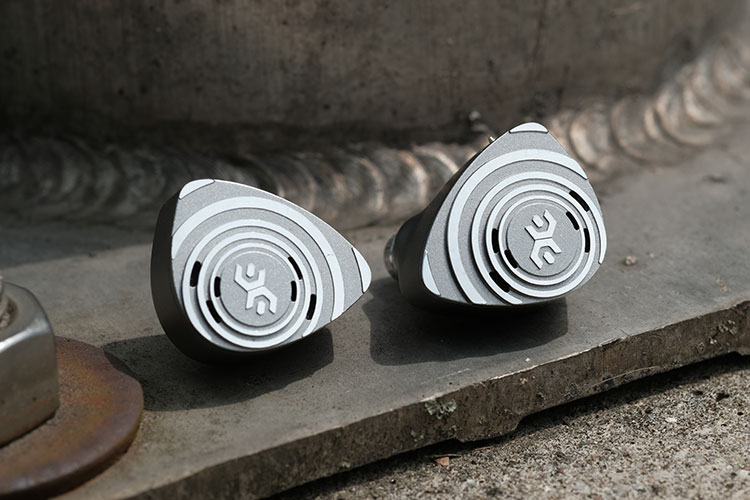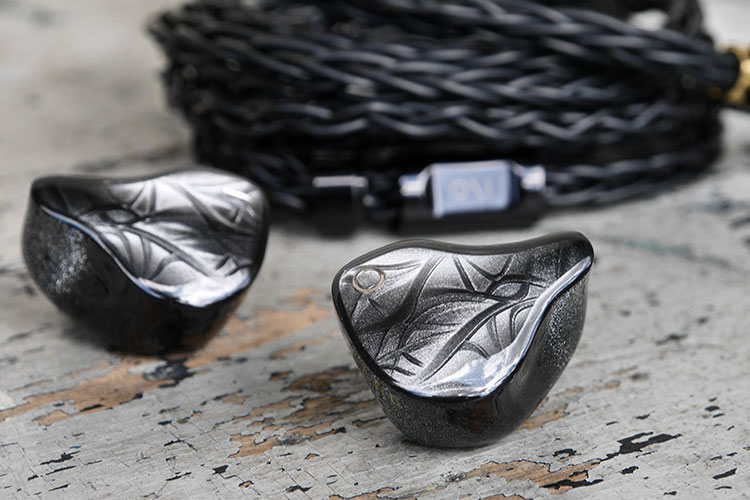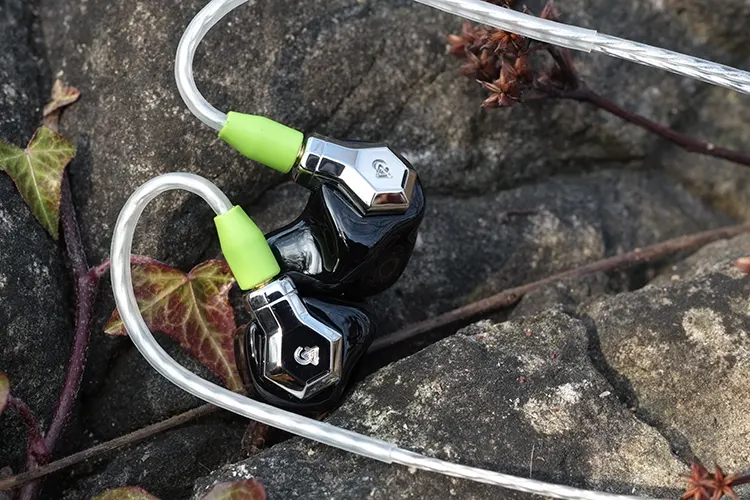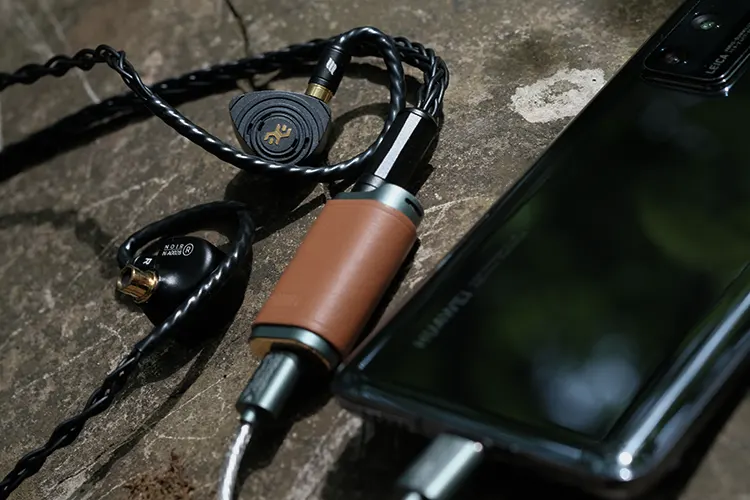Selected Comparisons
Elysian Acoustic Labs PILGRIM
Technical
While both earphones are hybrids with one dynamic, three balanced armatures, and a crossover, there were several alterations to make the PILGRIM NOIR.
The 9.2mm LSR (Liquid Silicone Rubber) dynamic driver is the same between both models. The differences start with the midrange drivers.
Effect Audio’s take on the PILGRIM doubles up the Sonion 2300 armature in what they call the Hypercore Twin Thrust Module (HTTM), which fires both drivers into a single custom sound tube. I want to meet whoever named that because it’s awesome.
This new setup optimizes one driver to handle low-mid frequencies and the other upper-mid frequencies. This differs from the standard PILGRIM, in which the single 2300 armature handles all midrange frequencies.
For the highs, the standard PILGRIM uses dual Sonion E50 armatures. For the PILGRIM NOIR, these were replaced with a single Knowles armature of a new design.
What makes this new driver special is the undampened, tubeless design. This reduces resonance and improves the upper-frequency response while providing a smoother, more refined sound.
Lastly, the standard PILGRIM’s 3-way crossover has been upgraded to a 4-way model. This new crossover helps with the frequency division of the dual 2300 setup and better blends the various drivers to provide a cohesive, well-controlled soundscape.
The PILGRIM has a sensitivity of 101dB vs. the PILGRIM NOIR’s 103 dB, with the impedance of the PILGRIM being 9Ω to the PILGRIM NOIR’s 8.3Ω. Both models are more-or-less equally easy to bring up to volume.
Design
You’d be forgiven for thinking these two models use the same shell. The PILGRIM NOIR is based on the PILGRIM after all.
That’s not the case though. While the faceplates are the same (as far as I can tell), and the general shape is the same, the PILGRIM NOIR is thicker and a little heavier (6.8g vs 7.6g, left earpieces only, no tip).
This thickness change has the benefit of improving ergonomics. The rear of the shell no longer rubs against the outer ear, causing an uncomfortable hotspot.
For looks, both have appealing aesthetics with the same knoll-inspired waves covering the faceplate. If you want a more vibrant, eye-catching style the original bright silver PILGRIM stands out, whereas the blacked-out PILGRIM NOIR is considerably more subtle and subdued.
Since they both use Pentaconn connectors, the same OEM and third-party cable options are available. I prefer thin, light cables, so the original PILGRIM cable speaks to me, though the new Eros S:NOIR cable is a looker and feels like it will last forever thanks to the quality materials and build.
I could not hear a difference in isolation qualities between the two. While they won’t outperform a sealed all-BA unit, isolation is better than the vast majority of other heavily vented IEMs I’ve used, though keep in mind that mid-range tones tend to push through on both.
Performance
The bass on both models is mostly the same. The additional low-mid presence afforded by the additional 2300 armature adds to the perceived mid-bass quantity, giving the PILGRIM NOIR a thicker, warmer presentation overall.
The PILGRIM NOIR’s midrange presentation is warmer, more dense, and shows a more natural tonality with similar levels of detail and clarity. The PILGRIM NOIR is free of the sibilance heard on the regular PILGRIM.
The benefits of the additional 2300 driver and 4-way crossover in the PILGRIM NOIR are apparent. Effect Audio’s take on this Elysian creation has a more complete, well-rounded, and satisfying presentation.
The standard PILGRIM is brighter. The transition between presence and brilliance regions is more jarring and can get a bit harsh.
The PILGRIM NOIR is more refined and smooth. While it has a similar brilliance peak, the presentation is less fatiguing and more balanced with a softer note feel.
Technically both are impressive, easily picking up fine details and enabling clear note distinction. The standard PILGRIM’s leaner sound gives it a slight edge on perceived detail.
The PILGRIM NOIR has a closer default vocal positioning, which combined with the thicker presentation gives it a more intimate feel. Effects expand off into the distance a similar amount though, giving the PILGRIM NOIR’s stage a more dynamic and flexible range.
Imaging of the two is nearly identical with smooth and accurate channel-to-channel transitions. Tracking auditory movement and effects is easy with either model.
The standard PILGRIM has an edge on instrument separation thanks to the thinner note presentation. The more flexible staging of the PILGRIM NOIR provides a more convincing sense of layering.
Overall, the PILGRIM NOIR provides a similar tuning style and level of technical performance. The benefits of the driver changes are apparent in the additional refinement, removing the sibilance and treble harshness within the PILGRIM.
I/O Audio VOLARE
Technical
The VOLARE has a 3D-printed acrylic shell compared to the PILGRIM NOIR’s aluminum shell. While considerably larger and with a higher driver count, the VOLARE is over a gram lighter and has a more ergonomic design.
The PILGRIM NOIR utilizes Pentaconn connectors versus VOLARE’s more common 0.78mm 2-pin system. The 2-pin system used by the VOLARE opens up tons of 3rd party cable options but durability falls behind, and the Eros S:NOIR cable is already an upgrade from most stock cables, including the VOLARE’s.
The PILGRIM NOIR is a quad-driver hybrid with one 9.2mm LSR dynamic and three balanced armatures from Sonion and Knowles.
The VOLARE is a tribrid containing nine drivers: one 8mm birch dome/silicone rubber surround dynamic, four custom balanced armatures, and four SONIC (not Sonion) electrostatic (EST) drivers imported from Denmark.
The PILGRIM NOIR has a sensitivity of 103 dB compared to the VOLARE’s 121 dB. The VOLARE’s impedance is 4.8Ω to the PILGRIM NOIR’s 8.3Ω. It takes less effort to bring the VOLARE up to comfortable listening volumes.
Design
Both models have ergonomic designs, with the VOLARE’s being more curvaceous and better shaped to conform to the outer ear. It’s quite a bit larger, leaving the PILGRIM NOIR the better option for those with smaller ears.
While considerably larger and containing more than double the number of drivers, the VOLARE is noticeably lighter (5.9g vs. 7.6g). Using aluminum for the PILGRIM NOIR keeps it light, just not to the extent of a pure acrylic shell.
This lightness, combined with an ergonomic shape helps the VOLARE provide a better wearing experience over long periods as there are no sharp edges or hotspots causing protrusions. The PILGRIM NOIR is certainly a step up from the standard PILGRIM thanks to the added thickness, but it is never quite as secure as the VOLARE.
Both are attractive designs but for different reasons. While the PILGRIM NOIR goes for an all-black, more traditional hi-fi aesthetic, the VOLARE’s organic faceplate design and sparkle-imbued resin housings attract more attention.
Passive isolation from the PILGRIM NOIR is good for heavily vented IEMs but falls behind what the VOLARE offers. Thanks to the larger, ear-filling body and deeper insertion, the VOLARE does a better job of dulling the environment.
Performance
The bass out of the VOLARE isn’t as quick, controlled, or well-textured but provides more slam and a better mid-bass/sub-bass balance. Quantity is plentiful on both models, with the VOLARE being the bassier and more visceral.
Leading into the mids, the two are exceptionally similar. Both have a pleasing and accurate tonality, warmth, and weightiness. The VOLARE has a slight edge in clarity and coherence with everything coming across that much crisper and more intelligible.
Treble from the VOLARE provides more shimmer and sparkle with a similar resistance to harshness and fatigue. Notes out of the PILGRIM NOIR are less tight and distinct with slower decay and softer attack.
While the treble presentation of the PILGRIM NOIR is a notable improvement over the original PILGRIM, the VOLARE is improved further still. That said, the additional brightness of the VOLARE will be a turnoff for some users.
Staging on both is excellent, but the VOLARE is a small step ahead. The default vocal positioning is further out and sounds are permitted even more distance away from the ear, with a similar level of intimacy possible.
Additional spacing between notes and improved depth give the VOLARE a more encompassing presentation. The PILGRIM NOIR matches the Volare in layering and separates instruments and effects nearly as well though.
The two IEMs go neck and neck in terms of performance, with the VOLARE having a small edge in a few areas. The extra bass and treble present in the VOLARE may be too much for some, so if choosing between the two and with the chance to audition them first, be sure to do so to see which style of tuning you prefer.
Campfire Audio Ponderosa
Technical
Campfire Audio’s Ponderosa has a dense acrylic shell with a stainless steel faceplate, whereas the PILGRIM NOIR uses aluminum. The Ponderosa is considerably larger but only about half a gram heavier.
The PILGRIM NOIR’s Pentaconn connectors limit third-party cable options, but the quality of the stock cable makes up for this. The Ponderosa uses a much more common MMCX connector featuring a unique, durable Beryllium Copper alloy, which opens countless upgrade options.
Effect Audio’s PILGRIM NOIR is a quad-driver hybrid with one dynamic and three armatures. In comparison, the Ponderosa exclusively uses balanced armatures, five in total.
The PILGRIM Noir has a sensitivity of 103dB and an impedance of 8.3Ω. In comparison, the Ponderosa has a sensitivity of 94dB and an impedance of 6Ω. Surprisingly, the Ponderosa is considerably easier to bring up to volume.
Design
Where the PILGRIM NOIR has a simpler, more traditional triangular design with subtle curves, Campfire Audio took a completely different direction with the Ponderosa. With a shape made from averaging thousands of ear impressions, the result is a large, bulbous earphone with curves everywhere.
The large size will limit who can wear it, but if it fits you the Ponderosa will be more ergonomic. It fills the entirety of the outer ear, and the various protrusions lock it into place so there is next to no movement, regardless of what you’re doing.
A smaller size and aggressive ear hooks ensure the PILGRIM NOIR is a good-fitting product. However, the shallower fit and lack of protrusions keep it from offering the same fit security as the Ponderosa.
Visually, once again both models are attractive but I feel the PILGRIM NOIR is more so. The gold logos and accents combined with the rolling waves on the faceplate are more interesting to my eye than the Ponderosa’s angular stainless-steel faceplate, which also happens to scratch quite easily.
The Ponderosa’s silver wiring and striking green cable hardware, if you opt for it, make it more interesting. Still, the Eros S:NOIR hardware is more impressive in design and material quality.
Isolation of the Ponderosa is a step up from the PILGRIM NOIR. The large ear-filling housing and single vents block out more noise, even if you’ve equipped the PILGRIM NOIR with foam or multi-flange tips.
Performance
Given the different driver types used, these two IEMs have very different low-end presentations. The PILGRIM NOIR has considerably more sub-bass emphasis and better extension giving it a more visceral output and generally bass-focused sound.
The Ponderosa is more balanced and focused on providing a snappy, punchy, highly textured presentation with added mid-bass warmth that elevates quantity just above neutral.
Moving to the midrange, the Ponderosa is more forward and thick with a more natural, organic tonality. The PILGRIM NOIR has the advantage of resolution and clarity aided by a thinner presentation.
Neither is sibilant and each provides good texturing for breathy vocalists, though the PILGRIM NOIR has the advantage.
Treble from the PILGRIM NOIR has a better extension with more brilliance region emphasis, giving it a brighter, more vibrant presentation. The Ponderosa on the other hand focuses squarely on the presence region giving it a slight edge in clarity and detail retrieval.
Both IEMs present notes without any slop or splash and are quite well-controlled. The PILGRIM NOIR has a smoother presentation though, particularly in the lower treble where mild harshness can occasionally creep in on the Ponderosa.
Staging on the PILGRIM NOIR is wider and deeper with a default vocal positioning sitting further from the inner ear. It also offers more space between instruments.
From there, the Ponderosa offers a more technical performance. Channel-to-channel imagining is more precise, and tracks come across as more layered, though individual track elements are equally as well separated.
The Ponderosa provides a more balanced, neutral-leaning signature with a more intimate, technically adept presentation. The PILGRIM NOIR is almost as technically impressive, built into a more vibrant, energetic signature that makes for a more exciting but less accurate listen.
My Verdict
Effect Audio and Elysian Acoustic Labs have collaborated to take an already excellent earphone to the next level.
Their new driver arrangement, crossover, and resulting tuning adjustments have fixed all my concerns with the sound of the standard PILGRIM. The updated shell has also addressed the ergonomic issues I ran into.
The improved midrange and overall smoother presentation add a healthy dose of refinement to the PILGRIM recipe. The result is a mature, engaging earphone with impressive genre versatility.
The new Eros S:NOIR cable is a design and material upgrade, but a step back in noise resistance and memory. This is worth it, however, since you now have access to the ConX and TermX modular plug systems which add plenty of flexibility to the cable should you wish to add additional termination options.
It is a little disappointing that the accessory kit wasn’t expanded upon, but at least third-party tips are readily available and often quite affordable. Still, a more comprehensive set of extras is always welcome since they give buyers a better chance to find the right setup, straight out of the box.
The $799 Effect Audio x Elysian Acoustics Labs PILGRIM NOIR has a smooth but engaging signature, a strong visual appeal, a premium cable, and great build quality. It is a very good IEM and well worth an audition.
Effect Audio PILGRIM NOIR Specifications
- Frequency Response: 10Hz–20kHz
- SPL: 103dB @ 1 kHz @ 100mV
- Impedance: 8.39Ω @ 1 kHz





